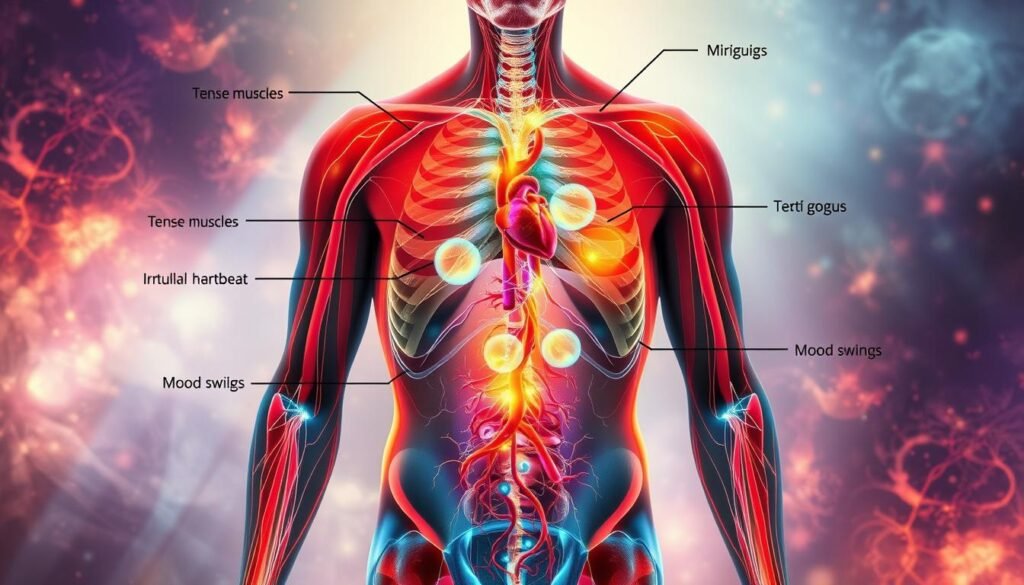About 12% of patients in hospitals lack enough magnesium, even though foods rich in it are common. This mineral is key for muscle work, making energy, and keeping the mind healthy. Yet, it can be tricky to spot a shortage without looking for certain signs. Alarmingly, nearly half of the U.S. population falls short on their daily magnesium needs. This shortfall can cause muscle cramps and tiredness. Knowing the signs of low magnesium is crucial, especially for older adults and those with ongoing health issues.
Key Takeaways
- Magnesium deficiency affects a significant portion of the population, particularly those with certain health conditions.
- Symptoms of lack of magnesium can range from mild to severe and may go undetected.
- Individuals over 60 are more susceptible to low magnesium levels due to aging-related absorption issues.
- Recognizing magnesium deficiency symptoms early can prevent more serious health complications.
- Dietary sources of magnesium include greens, nuts, seeds, and whole grains, which should be incorporated for better health.
- Correcting underlying health problems is essential for addressing magnesium deficiency effectively.
Understanding Magnesium Deficiency
Magnesium deficiency happens when the body doesn’t get enough magnesium from food. It’s important for many body functions like muscle and nerve health, bone strength, and keeping blood sugar levels right. If you don’t eat enough magnesium-rich foods or have certain health issues, you might not have enough magnesium.
Many things can cause low magnesium levels. Drinking too much alcohol, severe burns, ongoing diarrhea, peeing a lot, kidney problems, trouble absorbing nutrients, not eating well, some medicines, pancreatitis, and sweating a lot can all lead to this issue. These problems make it hard for the body to keep or get enough magnesium.
Normal magnesium levels in your blood should be between 1.3 to 2.1 mEq/L. If it’s not within these ranges, you might feel really tired, have muscle cramps, seizures, or unusual eye movements. Not fixing low magnesium can be very serious, leading to heart or breathing problems.
To fix a magnesium deficiency, doctors might give intravenous fluids or magnesium pills. Checking magnesium levels in your blood is key to know if you have this problem. People showing symptoms or those with certain health issues should get checked often.
Signs of Low Magnesium Levels
Low magnesium levels can show in many signs. Spotting these magnesium deficiency warning signs is key for good health. Common signs include:
- Low appetite or sudden changes in food preferences
- Fatigue that doesn’t resolve with rest
- Nausea or gastrointestinal discomfort
- Muscle spasms or cramps
Magnesium deficiency is uncommon for those eating well. But, some conditions can lead to it. It’s important to catch it early to avoid serious problems. Over time, not having enough magnesium could lead to:
- High blood pressure
- Osteoporosis
- Irregular heartbeat or arrhythmias
Knowing the magnesium deficiency warning signs is crucial. This helps people get the help they need quickly. If you have these symptoms, seeing a doctor is a good idea.

| Common Symptoms | Potential Health Risks |
|---|---|
| Low appetite | Increased blood pressure |
| Fatigue | Osteoporosis |
| Nausea | Irregular heartbeat |
| Muscle cramps | Diabetes |
Magnesium Deficiency Symptoms
Understanding magnesium deficiency symptoms is key for good health. The body uses magnesium in many ways. Not having enough can lead to clear signs.
Muscle Twitches and Cramps
One sign is muscle twitches and cramps. This problem happens when magnesium levels are too low. It’s a warning sign that shouldn’t be ignored.
Fatigue and Muscle Weakness
Fatigue and muscle weakness show magnesium deficiency. Magnesium is important for energy. Without it, you might feel tired and weak during daily activities.
High Blood Pressure
Low magnesium might cause high blood pressure. This issue is dangerous for the heart. It shows why magnesium is vital for controlling blood pressure.
Mental Health Issues
Lacking magnesium can affect your mind. It may lead to more anxiety and trouble sleeping. Good magnesium levels are crucial for staying mentally healthy.

To learn more about dealing with low magnesium, check out this detailed guide on symptoms of lack of magnesium.
Other Health Risks Associated with Magnesium Deficiency
Magnesium deficiency can lead to significant health risks that affect our well-being. Osteoporosis and irregular heartbeat are major concerns. Knowing the long-term effects of not having enough magnesium is key to staying healthy and preventing serious illnesses.
Osteoporosis
Magnesium is crucial for keeping bones strong. A lack of it raises the risk of osteoporosis. With not enough magnesium, our bones can become weak and fragile.
Research shows people with low magnesium intake are more likely to suffer bone issues. This makes it important to eat magnesium-rich foods. Dark-green veggies, nuts, and whole grains are great sources.
Irregular Heartbeat
Low magnesium levels can also cause irregular heartbeats, or arrhythmias. Studies show that not having enough magnesium can worsen heart rhythm problems. This can lead to severe health issues.
However, getting enough magnesium might help prevent these problems. It’s important to manage magnesium levels for a healthy heart.

Causes of Magnesium Deficiency
Many people don’t eat enough foods high in magnesium. This leads to not getting enough magnesium. Foods like green leafy vegetables, nuts, seeds, and legumes are key sources. Sadly, these vital foods are often missing from today’s diets, causing a lack of magnesium.
Long-term illnesses greatly lower magnesium levels. Issues like Crohn’s disease and celiac sprue make it hard for the body to absorb magnesium. This makes the magnesium issue worse. Also, proton-pump inhibitors and diuretics affect magnesium. These medications are common and can cause low magnesium levels.
Chronic alcoholism is closely linked to low magnesium levels, leading to the most common electrolyte issue among alcoholics. Research shows many patients in hospitals, especially ICUs, have magnesium deficiencies. Astonishingly, 80% have low magnesium in the first 48 hours after a heart attack, highlighting magnesium’s importance for heart health.
Genetics play a role in magnesium loss. Conditions like Gitelman-like diseases affect how magnesium is processed and absorbed. Past farming has also reduced magnesium in soil, affecting food magnesium levels. It’s estimated that processed foods lose up to 90% of their magnesium, making it hard to get from diet alone.
| Cause of Magnesium Deficiency | Details |
|---|---|
| Low Dietary Intake | Insufficient consumption of magnesium-rich foods, such as vegetables and nuts. |
| Chronic Health Conditions | Diseases like Crohn’s and celiac disease hinder magnesium absorption. |
| Medications | Diuretics and proton-pump inhibitors can exacerbate magnesium depletion. |
| Chronic Alcoholism | Strongly linked with hypomagnesemia, leading to widespread nutrient deficiencies. |
| Genetic Factors | Inherent metabolic disorders affect magnesium absorption. |
| Agricultural Practices | Depletion of magnesium in soils reduces the nutrient content in food. |
Identifying Magnesium Deficiency
Spotting a magnesium deficiency means looking for key physical signs. These include feeling sick, tired, weak in your muscles, and having an uneven heartbeat. If you notice these signs, it’s a good idea to check your magnesium levels. This is especially true for men over 70 and teens, who often get less magnesium.
Tests like blood or urine analyses are crucial in confirming a magnesium deficiency. A doctor can advise on which tests to take. For good health, adults need 320–420 milligrams of magnesium each day. Yet, many American adults do not get enough.
But it’s not all about body aches or tiredness. A big lack of magnesium can cause severe issues. Problems like very low calcium, heart failure, or seizures can happen. If you’re seeing many warning signs, acting fast is key. Changing your diet or taking supplements can help increase magnesium. For tips on magnesium supplements, check out this guide on magnesium for anxiety.
How to Recognize Magnesium Deficiency
Identifying magnesium deficiency involves different diagnostic steps. It also means knowing the common risk factors. It’s crucial because many people don’t get enough magnesium. About 75% of people don’t meet their daily magnesium needs. This fact highlights why it’s important to check magnesium levels, especially in those most at risk.
Diagnostic Tests
Blood tests for magnesium might not always catch a deficiency. They’re widely used but might miss when the deficiency is slight. In 2009, the World Health Organization pointed out the need for better testing methods. Experts now suggest keeping blood magnesium levels at 0.9 mmol/l to find those who are deficient.
Common Risk Factors
Several factors can make magnesium deficiency more likely. These include being older, certain lifestyle habits, and having gastrointestinal diseases. Low magnesium is common in countries with modern lifestyles. It’s hard to keep track of those at risk because we lack precise tests. Still, finding ways to identify magnesium deficiency is key for improving health.
| Risk Factors | Impact |
|---|---|
| Age 60 and above | Higher likelihood of deficiency |
| Gastrointestinal diseases | Impaired magnesium absorption |
| Poor dietary habits | Inadequate intake of magnesium-rich foods |
| Chronic stress | Increased magnesium depletion |
Increasing Magnesium Levels
To fight off magnesium deficiency, think about how to up your magnesium levels. Changing what you eat and considering supplements is key. First, eat more foods high in magnesium. Great choices include:
- Leafy green vegetables such as spinach and kale
- Nuts and seeds, including almonds and pumpkin seeds
- Whole grains like quinoa and brown rice
- Legumes such as black beans and lentils
- Tofu and dark chocolate for those sweet cravings
If you’re not getting enough magnesium from food, doctors might suggest supplements. Always talk to a doctor before starting supplements. This will help avoid any negative reactions or conflicts with your medications. Remember, supplements can cause stomach issues like diarrhea, so use them wisely.
Some people find keeping up with magnesium harder than others. For example, those with type 2 diabetes or gut diseases may struggle more. Drinking too much alcohol and not eating enough nutritious foods also affect your magnesium levels.
Not having enough magnesium for a long time can lead to big health problems like heart disease and osteoporosis. Being aware of your magnesium consumption helps keep you healthy. Adding foods rich in magnesium to your meals is a smart move. This way, you can keep your magnesium levels up and improve your health.
| Food Source | Magnesium Content (mg per 100g) |
|---|---|
| Spinach | 79 |
| Almonds | 268 |
| Quinoa | 64 |
| Lentils | 36 |
| Dark chocolate (70-85% cocoa) | 228 |
Conclusion
It’s important to keep magnesium levels right for good health. Knowing the signs of low magnesium lets people act early in caring for their health. Men should get 350 mg and women 300 mg of magnesium daily, says the German Nutrition Society (DGE). Eating foods like leafy greens, nuts, and whole grains helps avoid shortages.
Blood tests can show your magnesium levels, which should be between 29.8–39.1 mg/l for health. Keeping an eye on these numbers is crucial. This is because low magnesium can cause serious problems. For instance, it can lead to heart issues and muscle spasms, especially in older women and those with long-term health problems. Making changes to what you eat or taking supplements can improve your health a lot.
If you think you might not have enough magnesium, it’s a good idea to talk to a doctor. For more information on this subject and how it affects health, you can read more on Medical News Today. Sticking to a healthy diet and being proactive about health can lower the risks of not having enough magnesium, leading to a healthier lifestyle.